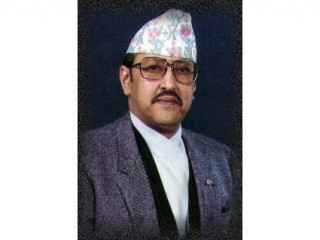
King Birendra biography
Date of birth : 1945-12-28
Date of death : 2001-06-01
Birthplace : Kathmandu, Nepal
Nationality : Nepali
Category : Politics
Last modified : 2011-09-01
Credited as : King of Nepal, royal massacre 2001,
Coming to the throne of Nepal at the age of 27 King Birendra sought to emphasize economic development and a decentralization of authority.
King Birendra (Bir Bikram Shah Dev) of Nepal was born on December 28, 1945, the eldest son of King Mahendra and Queen Indra. He had two brothers and three sisters, as well as numerous aunts, uncles, and cousins in the royal family entourage in and around the palace in Nepal's capital city. Birendra married Aishwarya R.L. Rana on February 23, 1970; they had three children— Crown Prince Dipindra, Prince Nirajan, and Princess Shruti.
Birendra was born while the Rana family still dominated the government of Nepal and the royal family was kept under strict surveillence. But the political movement that overthrew the Ranas occurred when the crown prince was only five years old, and his socialization into politics and society in Nepal and abroad was very different from that of his father, King Mahendra. Birendra's formal education, for instance, was in prestigious schools outside Nepal: St. Joseph's in Darjeeling, India; Eton in England; Harvard University; and the University of Tokyo. In the process, he was exposed to a rich assortment of theories and models on political and economic change in "developing" societies like Nepal, and he demonstrated an open and inquisitive mind on such subjects.
King Birendra came to the throne on January 31, 1972, the tenth ruler in the Shah dynasty in Nepal. He quickly demonstrated a different approach to the processes of governance than those adopted by his predecessor, and important changes in both the style and substance of policies were introduced. The preoccupation of King Mahendra with the minutia of political developments anywhere in Nepal was replaced by a new strategy that, in effect, downgraded politics and focussed instead on economic development themes and issues. The objective was to insulate economic programs from the narrow political and interest group concerns that had, supposedly, hampered their implementation under his father.
As a necessary accompaniment to this new approach, changes in the entourage of advisors around the king were required. The groups of experienced and politically astute bureaucrats that King Mahendra had used were quickly replaced by younger, well-educated "modernistic" technicians who presumably would be less inhibited by concerns for traditional familial or caste group interests. A new institution under direct palace supervision was established to do the necessary policy planning, usually with minimal participation by the "narrow" interest groups directly affected by these policies and programs. To manage politics outside of Kathmandu, the BVNC (Back-to-the-Village National Committee) was organized to assure the palace a controlling voice in regional and local councils on development programs.
The new approach sounded reasonable, but the results were less than impressive. While few institutions or persons directly challenged the palace coteries, few cooperated with their programs. A number of well-conceived policies in the education, health, and economic fields were adopted, but the officials and institutions that were supposed to implement them were virtually non-operative. By the late 1970s it was clear that some major changes in the palace's approach were necessary. King Birendra took several significant steps to meet the situation. In 1980 he held, on a universal suffrage basis, a popular referendum on the constitution his father had introduced in 1962. The vote went slightly in favor of the existing system, but with reforms. Birendra then introduced several basic changes in the constitution, including provisions for the election of the Rashtriya Panchayat (National Assembly) on a popular but non-party basis and the selection of a prime minister by the Assembly. The Assembly was elected in 1981; one prime minister was elected and then later removed by the Assembly on a non-confidence vote, and another prime minister installed.
Thus, the trappings of a democratic parliamentary system were in place in Nepal, but several necessary ingredients were lacking—primarily a legalized political party system. Freedom of speech, press, and assembly were more evident in the 1980s than at any other time since 1960, but still with some limitations. The palace continued to be the source of authority on all major issues, and the Assembly and the cabinet had no really effective limitations on the royal powers. If Nepal was booming ahead economically, this might be of only limited importance, but for a decade or more there was virtually no real economic growth.
King Birendra, thus, had a number of difficult decisions to make, and within a limited time frame. His dedication to Nepal's welfare was accepted by most Nepalis, but there was more skepticism about the intentions of some of the important people in and around the palace. Birendra's announcement of his intention to introduce a substantive decentralization program which would transfer decisionmaking authority on many important issues from the Kathmandu bureaucracy to local and regional elected officials had the potential to be an important step in meeting some of Nepal's basic political, social, and economic problems. While King Birendra's intentions were not questioned, there were doubts about his ability to implement such a program within the existing political system.
















